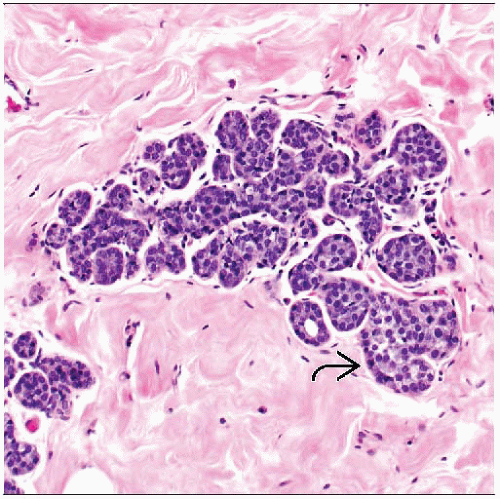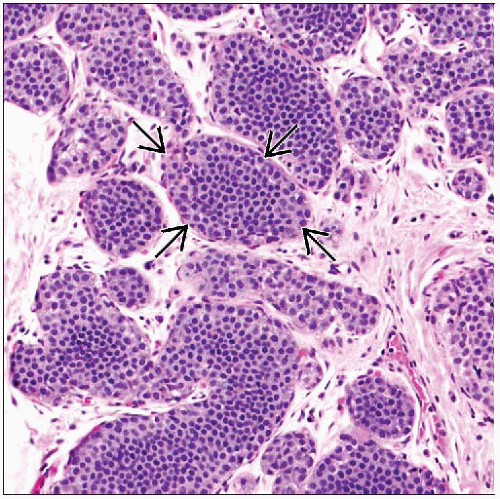Atypical Lobular Hyperplasia
Key Facts
Terminology
ALH is cytologically identical to LCIS but is more limited in extent
Term “lobular neoplasia” (LN) includes both ALH and LCIS
Etiology/Pathogenesis
The hallmark feature of ALH, LCIS, and invasive lobular carcinoma is loss of E-cadherin expression
Clinical Issues
ALH is an incidental finding in breast biopsies performed for other indications
ALH is considered a nonobligate cancer precursor with increased risk of developing invasive carcinoma
Relative risk is 4-5x
Approximately 13-17% of women will develop invasive breast cancer in their lifetimes
60% of cancers develop in the same breast and 40% in the contralateral breast
Microscopic Pathology
ALH is composed of a monomorphic population of polygonal or cuboidal cells that are small and round
Cells are loosely cohesive and regularly spaced
Overall lobular architecture is maintained
ALH may secondarily involve other benign lesions
Top Differential Diagnoses
Lobular carcinoma in situ
Poor tissue preservation
Myoepithelial cells
Low-grade DCIS
TERMINOLOGY
Abbreviations
Atypical lobular hyperplasia (ALH)
Synonyms
Lobular intraepithelial neoplasia 1 (LIN1)
Definitions
ALH is cytologically identical to lobular carcinoma in situ (LCIS) but is more limited in extent
Term “lobular neoplasia” (LN) includes both ALH and LCIS
ETIOLOGY/PATHOGENESIS
Molecular Pathology
The hallmark feature of ALH, LCIS, and invasive lobular carcinoma is loss of expression of the E-cadherin gene (CDH1)
E-cadherin plays a major role in intercellular adhesion and cell polarity
Loss of E-cadherin membrane expression can be shown by immunohistochemistry
Loss of expression is accompanied by E-cadherin DNA alterations in LCIS but not in ALH
Suggests that E-cadherin may be inactivated by means other than mutation in ALH
ALH and LCIS share similar losses and gains of DNA
Loss at 16q21-q23.1 (location of E-cadherin gene)
Gain at 14q32.33 (site of AKT1 gene) (involved in luminal morphogenesis)
Genetic changes in invasive lobular carcinomas can also be found in adjacent LN
Evidence that LN may be a precursor lesion for invasive carcinoma
However, LN is a nonobligate precursor as the majority of women with ALH do not develop invasive carcinoma
CLINICAL ISSUES
Epidemiology
Incidence
ALH and LCIS without invasive carcinoma are found in only 0.5-4% of breast biopsies
Incidental findings in biopsies performed for other indications
True incidence of ALH in the general population is unknown
Age
ALH is more common in premenopausal women (peak incidence in mid 40s)
Site
ALH can be multicentric and is frequently bilateral
Presentation
Asymptomatic
Treatment
In order to reduce risk, both breasts require treatment
Chemoprevention with tamoxifen reduces risk of ER-positive invasive carcinoma
Bilateral mastectomy reduces risk
However, the majority of women will not develop invasive carcinoma, and most choose surveillance
Prognosis
ALH is associated with a 4-5x increased relative risk or a 13-17% lifetime risk of developing invasive carcinoma
In some studies, a strong family history of breast cancer doubles risk of invasive carcinoma to 8x
Ductal involvement by ALH (pagetoid extension) is associated with 8x risk or a 26% lifetime risk
LCIS has a 10x increased relative risk or a lifetime risk of ˜ 30%
Carcinomas that occur in women after a diagnosis of LN average > 10 years to diagnosis
Up to 1/2 of subsequent cancers show classic or variant patterns of special type histology with a good prognosis
Likelihood of developing an invasive lobular carcinoma is 3x higher than in the general population
Stay updated, free articles. Join our Telegram channel

Full access? Get Clinical Tree






